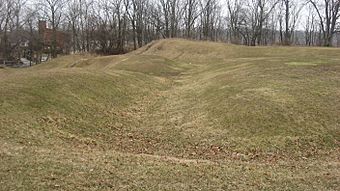Fort Miami (Ohio) facts for kids
Quick facts for kids |
|
|
Fort Miamis Site
|
|

Earthworks at the site
|
|
| Location | Along the Maumee River in Maumee, Ohio |
|---|---|
| Area | 3.7 acres (1.5 ha) |
| Built | 1794 |
| NRHP reference No. | 75001466 |
| Added to NRHP | June 18, 1975 |
Fort Miami was a British fort built in 1794. It was located on the Maumee River in what is now Maumee, Ohio. At that time, this land was part of the United States' Northwest Territory. The British built Fort Miami to try and stop an American army. This army was led by General Anthony Wayne. He was moving north in Ohio towards Fort Detroit.
Contents
Why the Fort Was Built
Land Disputes After the Revolution
The American Revolutionary War ended in 1783. The Treaty of Paris (1783) was signed. This treaty gave the United States a large area of land. This land was south of the Great Lakes. It was also between the Ohio River and Mississippi River.
However, the British did not leave their forts in this area. They said the U.S. had not followed parts of the treaty. For example, old debts owed to British merchants were not paid. Also, property belonging to people loyal to Britain was still being taken.
Protecting British Interests
In the early 1790s, a British leader named John Graves Simcoe tried to help Native American tribes. These tribes were part of the "Northwestern Confederacy". They included the Shawnee, Miami, and Wyandot. They were fighting American settlers in the Northwest Indian War.
Simcoe wanted to create a special "Indian barrier state". This would be a Native American-controlled area. It would protect Britain's fur trade business. It would also block any attacks the Americans might plan. These attacks could be aimed at Britain's remaining lands in North America.
Fort Miami's Story
Building the Fort
In the spring of 1794, the British built Fort Miami. They wanted to stop U.S. General Anthony Wayne from reaching Fort Detroit. They also wanted to encourage the Native American tribes in their fight.
The fort was made of logs. It had four strong corners called bastions. Each bastion could hold four cannons. There was also a river battery, barracks for soldiers, and officers' quarters. Supply buildings and shops were also inside. A deep ditch, 20 to 25 feet deep, protected the fort from the land side.
The Battle of Fallen Timbers
In July 1794, General Wayne and his soldiers marched north. They were coming from Fort Recovery towards Fort Miami. South of Fort Miami, they met Native Americans and some Canadian militia. They had built a barricade. General Wayne ordered a charge. His troops quickly scattered their opponents in the Battle of Fallen Timbers.
The Native Americans ran to Fort Miami for safety. But the fort commander would not let them in. They were defeated and felt let down. The Native Americans then went their separate ways.
After the Battle
One year later, tribal elders met with General Wayne. They met at Fort Greenville. The Treaty of Greenville was signed. This treaty opened most of Ohio and part of Indiana for American settlement.
In 1796, the British finally left Fort Miami. This was part of the Jay Treaty (1794). They also left their other forts on American land. General Wayne's army took over the fort. But around 1799, it was left empty.
The War of 1812
The British used the site again during the War of 1812. At that time, it was across the river from the American Fort Meigs. During this war, Tecumseh, a Shawnee chief, and British officials had their headquarters at Fort Miami. From there, they planned attacks against General William Henry Harrison at Fort Meigs.
The fort was abandoned again in 1814. Over time, it was torn down. The land was then used for farming. Later, it became a public park.
Fort Miami Today
What Remains of the Fort
Today, the Fort Miami site is a small area. It is surrounded by houses. Nothing is left of the original fort structure. Only parts of the earthworks, which are mounds of dirt, can still be seen.
In 1942, some Ohio groups bought part of the fort site. In 1953, the Ohio State Archaeological and Historical Society did some digging. In 1957, the Historical Society of Northwestern Ohio put a marker at the site. The area remains undeveloped. In 1975, the fort site was added to the National Register of Historic Places.
National Historic Site
In 1999, the fort site became part of the Fallen Timbers Battlefield and Fort Miamis National Historic Site. This happened under Public Law 106-164. The Metropolitan Park District of the Toledo Area manages the site. They work with the Ohio Historical Society. It is also connected to the National Park System.
A state memorial has been created at the site. Also, Ft. Miami Elementary School is nearby. It is named after the fort.
Gallery






